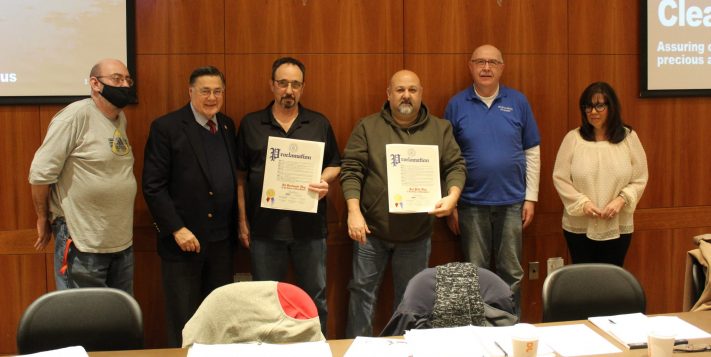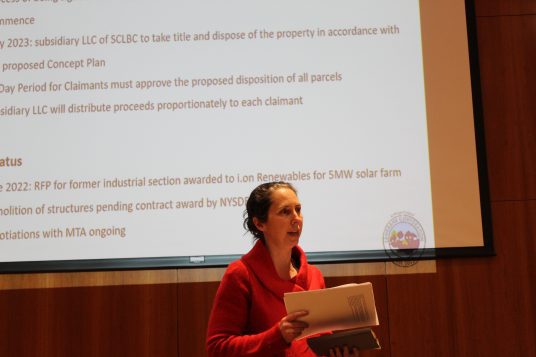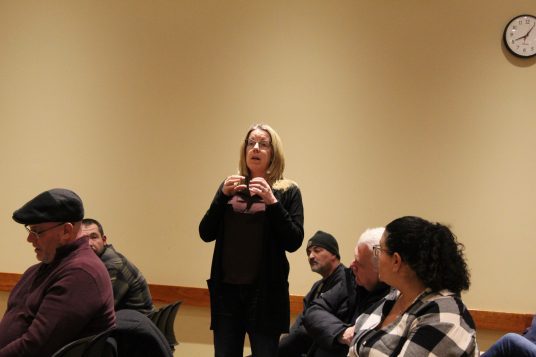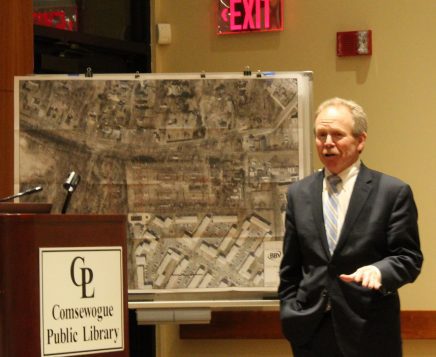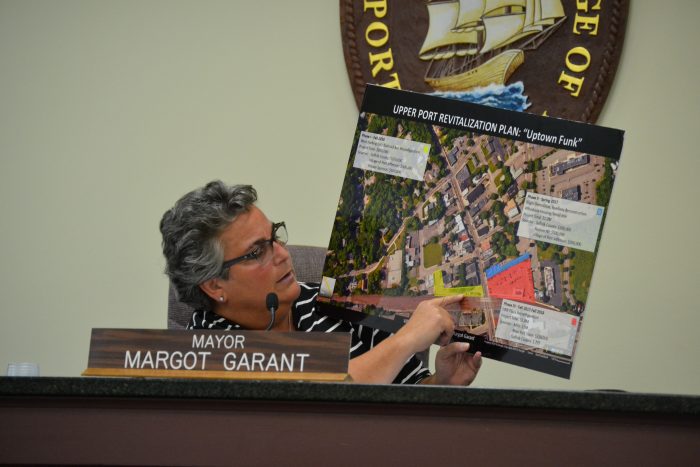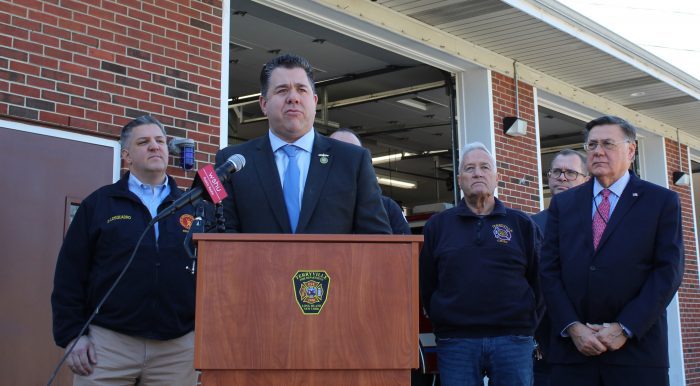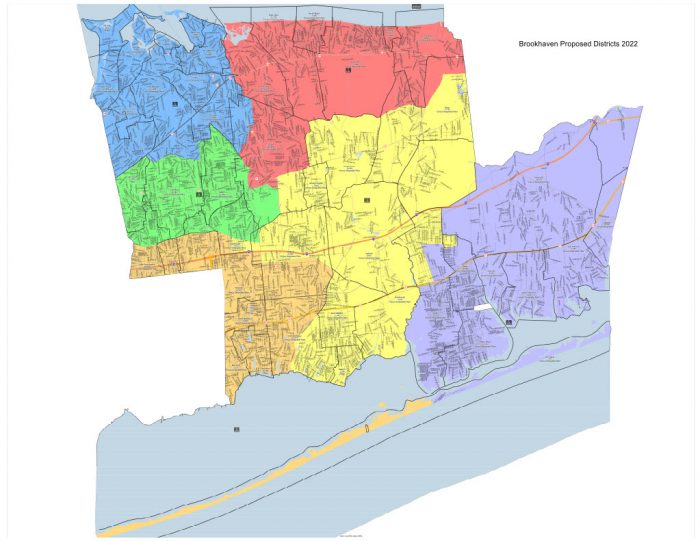The Port Jefferson Station/Terryville Civic Association met Tuesday, Feb. 28, for an evening packed with local business.
Lawrence Aviation
Sarah Lansdale, the Suffolk County economic development and planning commissioner, updated the body on the proposed conceptual layout of the Lawrence Aviation Superfund site in Port Jefferson Station.
“We have come up with a plan of three basic uses of the property,” she said. “One is a light-industry use … for a proposed solar development. The property south of the Greenway is proposed to be for open space … and then a railyard, or railroad usage, on the northeastern section of the property.”
Lansdale also reported that the U.S. Department of Justice recently approved language within a global settlement agreement between 11 claimants, adding, “Now we’re getting them to sign on to the agreement. Of the 11, we have three remaining that have yet to sign on.”
The county is working to finalize a bid package to demolish the remaining buildings on-site during the warmer months.
County Legislator Kara Hahn (D-Setauket) thanked Lansdale for continuing her efforts on behalf of county residents.
“Very few people want to deal with difficult, complex projects like this,” Hahn said. “This was very difficult, we are so close, and I’m just grateful.”
Civic member Ira Costell objected to a Feb. 23 op-ed in The Port Times Record, “Village elections and Port Jeff’s rapidly changing challenges,” in which former Port Jefferson Village trustee Bruce Miller suggested expanding the limits of the village to derive tax revenue from the Superfund site.
“I think that’s something we need to discuss and take a position on shortly,” Costell said, adding that such a proposal “impacts our community and a potential tax base to the Comsewogue School District.”
Civic president Ed Garboski and vice president Sal Pitti objected to the annexation proposal. Corresponding secretary Charlie McAteer said a discussion on the matter would be appropriate during next month’s meeting.
County sewers
Deputy County Executive Peter Scully delivered a presentation outlining the county’s clean water initiative, remarking that a comprehensive sewer plan has eluded county officials for decades.
“Most of Suffolk County is without sewer infrastructure,” he said. “Sewers throughout Suffolk County have not happened for a variety of reasons,” namely the enormous costs associated with their construction.
Cesspools remain the only waste treatment technology available to many county residents, which Scully indicated can impair the sole-source aquifer upon which residents depend for their drinking water. Leakage associated with septic tanks, Scully said, can contribute to brown tides, rust tides, algal blooms and fish kills throughout the county’s waterways.
To address the problem, the administration is pitching the Suffolk County Clean Water Plan, which includes a one-eighth of a penny per dollar sales tax, to create a local match program for federal and state subsidization of sewer infrastructure.
“Right now, there are tremendous funding sources available on the federal and state levels,” he said, noting the $1.2 trillion Bipartisan Infrastructure Law passed by Congress in 2021 and the recently passed New York State $4.2 billion environmental bond act.
“Those are the two sources of funding that we’re all anxious to make sure our communities get a fair share of, and to do that we need a local match,” the deputy county executive said. “The [clean water plan] funding source that we’re talking about provides that local match.”
Reports
Andrea Malchiodi, assistant director of Comsewogue Public Library, announced that the library’s budget vote and trustee election would take place Tuesday, April 4.
Comsewogue High School students Kylie and Max updated the body on the news from the Comsewogue School District. Kylie reported that the high school’s business academy and work-based learning program were both approved career and technical education pathways by the New York State Education Department.
Max noted Comsewogue’s recent athletic achievements, with the Warriors girls and boys basketball teams advancing to the postseason. The wrestling team vied for the county final, while the varsity cheerleading team competed at the national tournament in Florida.
Suffolk County COPE officer Casey Berry said the vehicle theft crime surge throughout the local area remains unresolved. “Lock your cars in your driveway and when you’re going to Starbucks,” she told the body. “Don’t leave the fob in the car.”
Berry also reported that officers within the department are being more active. “I think COVID affected law enforcement as well as the rest of the community in many ways,” she said, adding, “Our leadership is saying, ‘We really need to protect our community.’”
This boost in police activity, Berry added, is reflected by rising numbers of summons written by police officers, along with the department’s ongoing body camera initiative.
Civic elections
Garboski reported the results of the nominating committee created last month after he and Pitti declared they would be leaving the hamlet before the year’s end, thereby vacating their posts.
Christine Allen and Costell were each nominated for the position of civic president, and Carolyn Sagliocca was the sole candidate nominated as vice president. The three candidates publicly accepted their nominations.
Additional nominations will be accepted from the floor during the next meeting March 28, on which date a vote will take place. The newly electeds will formally enter their posts in April.
During the meeting, Town of Brookhaven Supervisor Ed Romaine (R) presented proclamations to Garboski and Pitti for their long service to the Comsewogue community.
“You cannot put a price on the time, effort, energy, knowledge and dedication they have brought to this task,” Romaine said. “They have worked around the clock to improve the quality of not their lives, but the quality of life of everyone in this community.”

